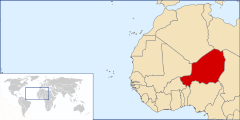Geography of Niger
 
|
|
| Continent | Africa |
|---|---|
| Region | Western Africa |
| Coordinates | 16°00′N 08°00′E / 16.000°N 8.000°E |
| Area | Ranked 22nd |
| • Total | 1,266,700 km2 (489,100 sq mi) |
| • Land | 99.98% |
| • Water | 0.02% |
| Coastline | 0 km (0 mi) |
| Borders |
Land boundaries: |
| Irrigated land | 736.6 km² (2005) |
| Total renewable water resources | 33.65 km3 (2011) |
| Highest point | Mont Idoukal-n-Taghès, 2,022 m |
| Lowest point | Niger River, 200 m |
| Climate | Desert to tropical |
| Terrain | Mostly desert plains and sand dunes, hills in the north |
| Natural Resources | Uranium, coal, iron ore, tin, phosphates, gold, molybdenum, gypsum, salt, petroleum |
| Natural Hazards | Recurring droughts |
| Environmental Issues | Overgrazing, soil erosion, deforestation, poaching |
Land boundaries:
Algeria 951 km
Benin 277 km
Burkina Faso 622 km
Chad 1,196 km
Libya 342 km
Mali 838 km
Nigeria 1,608 km
Niger is a landlocked nation in West Africa located along the border between the Sahara and Sub-Saharan regions. Its geographic coordinates are longitude 16°N and latitude 8°E. Its area is 1.267 million square kilometers, of which 1 266 700 km² is land and 300 km² water, making Niger slightly less than twice the size of France.
Niger which attained independence from France in 1960 was under military regime till 1991. On public demand Gen. Ali Saibou held multiparty elections in 1993 and soon democracy came in to effect in 1993. However, political unrest was caused by Col. Ibrahim Bare who staged a coup in 1999, but he died in a counter insurgency operations by officers of the military establishment. This was followed by fresh elections for a democratic rule, and Mamadou Tandja assumed power in December 1999. Tandja,who won the elections in 2004 and in 2009, wanted to bring about a constitutional amendment to extend his tenure as president. However, in February 2010, he was removed from the post of the president in a coup engineered by the military and the constitution was annulled. Soon after, in 2011, elections were held and Mahamadou Issoufou got elected as the president and was sworn in April 2011. Niger’s problem with rebellious groups continued during 2007 and 2008. Rebellion was controlled. However, its security problems with its neighbors such as Libya, Nigeria and Mali have been a cause for concern
...
Wikipedia
